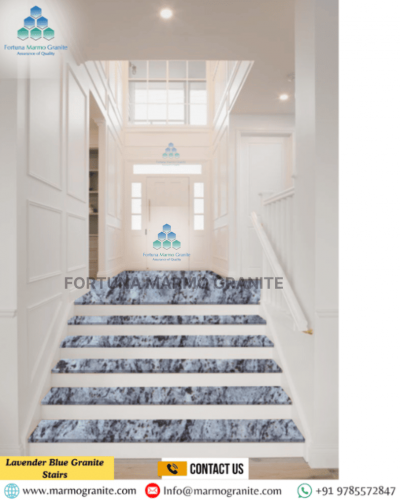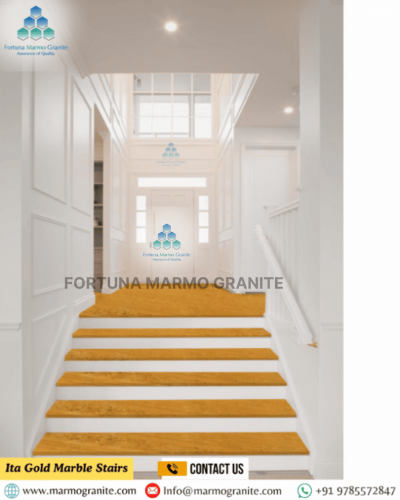Granite vs. Marble Stairs: A Complete Comparison for Style, Strength, and Budget
Granite vs. Marble Stairs Choosing the right material. for your staircase plays a big role in how your home looks and lasts over time. Stairs are not just a way to move between floors—they're often a main feature and face daily use. Yet, Two natural stones that stand out for their beauty and luxury are granite and marble. Both can turn an ordinary staircase into a showpiece.
Moreover, But granite and marble differ in how they're made, how strong they are, and how they hold up over time. Granite is harder and more resistant to scratches and stains. while marble has softer, elegant veining that adds a classic touch but needs more care. In addition, Even small differences in look or strength can affect your home's style, upkeep, and value. In addition, This comparison helps you understand the pros and cons. of granite and marble stairs. so you can confidently choose what fits your design, daily life, and budget best.
Marble: The Epitome of Elegance and Luxury
Marble is a top choice when you want to create a timeless, elegant, and luxurious staircase. Formed from crystallized limestone. its charm lies in the natural veining caused by mineral impurities—no two slabs are ever the same. making each staircase completely unique. In addition, The signature beauty of marble comes from its soft, flowing, and often dramatic veins. Whether it's the gentle gray lines of Carrara. the bold streaks of Calacatta, or the warm tones of Crema Marfil. the patterns give marble a graceful, artistic look.
Moreover, Its color palette is soft and refined, with classic whites and grays. along with lovely greens, blacks, and pinks. Thanks to its translucent nature, marble reflects light beautifully, brightening up any space. Most people choose a polished finish to highlight the veining and add a rich. glossy feel, but a honed finish offers a softer, modern touch. With marble, you get both beauty and a statement of style.
Granite: The Statement of Strength and Consistency
Granite is an igneous rock, formed from cooled magma, and its appearance reflects its tough origin. Yet, While it may lack the fluid veining of marble, it offers a visual strength and a vast array of intricate, speckled patterns.
- Speckled and Granular: Moreover, Granite's beauty is in its granular, crystalline structure. Its patterns are typically composed of a consistent distribution of flecks, speckles, and small veins. Yet, This gives it a more uniform and robust appearance. In addition, From the shimmering flecks of Black Galaxy to the earthy tones of Tan Brown, granite provides a grounded and durable aesthetic.
- Color Palette: The color options for granite are incredibly diverse, often more vibrant and earthy than marble. You can find stunning slabs in deep blacks, vibrant blues, striking reds, lush greens, and warm browns. The consistent pattern makes it easier to match and integrate into a variety of design styles, from modern and minimalist to rustic and traditional.
- Finishes: Granite is a versatile material that can be finished in multiple ways to achieve different looks and slip resistance. A polished finish creates a smooth, reflective surface that highlights the stone's depth. A honed finish gives a softer, matte appearance, while a flamed or leathered finish creates a rough, textured surface that is highly slip-resistant and perfect for a rugged, contemporary feel.
Strength, Durability, and Maintenance: The Practical Comparison
Granite: The Hardened Workhorse
Granite is one of the hardest natural stones available, with a rating of 6 to 7 on the Mohs scale of hardness. This makes it an incredibly durable choice for a staircase.
- Scratch and Chip Resistance: Moreover, Thanks to its high mineral content (mostly quartz and feldspar), granite is highly resistant to scratches, chipping, and etching. In addition, A dropped object or a dragging piece of furniture is far less likely to cause visible damage on a granite surface compared to marble.
- Porosity and Stain Resistance: Granite is a dense and less porous stone than marble. This means it is less susceptible to absorbing liquids and staining. While still recommended, sealing granite is generally done less frequently than marble and offers a higher degree of protection against spills like wine, oil, or acidic juices.
- Maintenance: Maintenance is straightforward for granite. Regular sweeping and an occasional wipe-down with a pH-neutral cleaner are usually. all that's needed. The low porosity and high durability make it a low-maintenance. option for busy households.
Marble: The Soft, High-Maintenance Star
Marble is a softer, more porous stone, rating between 3 and 5 on the Mohs scale. In addition, While it is durable enough to last for centuries, it requires a higher level of care and attention.
- Vulnerability to Etching and Stains: Moreover, Marble's primary mineral, calcite, reacts to acidic substances, leading to a dull mark known as "etching." Spills from citrus juice, vinegar, or certain cleaning products can easily damage the polished surface. Additionally, due to its higher porosity, marble can absorb stains if spills are not wiped up quickly.
- Scratch and Wear: Moreover, Marble is more prone to scratching and chipping than granite. Yet, The constant friction of shoes over a long period can also lead to a loss of the surface's polish, particularly in high-traffic spots.
- Maintenance: In addition, To maintain its pristine appearance, a marble staircase requires more diligent care. It must be sealed regularly, often once a year, to prevent staining. You must be careful to use only pH-neutral cleaners and wipe up spills immediately.
Budget and Cost: The Financial Factor
The cost of a stone staircase can be a significant investment, and the price difference between granite and marble can be considerable, though it depends heavily on the specific type and rarity of the stone.
- Material Cost: Moreover, Generally, marble is the more expensive of the two. Its reputation as a luxury material and the demand for exotic, rare varieties like. Calacatta and Statuario drive up the price. However, more common varieties like Carrara can be more affordable and. compete with the price of mid-range granites. Granite offers a broader range of price points. In addition, While some exotic types can be as expensive as rare marble. you can find a wide variety of beautiful and durable granites at a more accessible price.
- Installation Cost: Moreover, The labor cost for installing both materials is similar, but the process can be more complex for marble. Due to its brittleness, marble requires more careful handling and more precise cuts, which can sometimes increase the installation price.
- Long-Term Value: In addition, When considering the total cost. it's essential to think about long-term maintenance. Yet, While marble may have a higher upfront cost. for the material, its ongoing maintenance. including the need for more frequent sealing and. potential professional re-polishing to remove etches and scratches—can add up over time. Granite. Yet, with its superior durability and lower maintenance needs. offers excellent long-term value, resisting wear and tear for decades with minimal upkeep.
Making the Final Choice: A Summary Table
| Feature | Granite | Marble |
|---|---|---|
| Aesthetics | Speckled, granular, and consistent patterns. Available in a wide range of earthy and vibrant colors. | Soft, flowing, and dramatic veining. Primarily available in classic whites, grays, and creams. |
| Durability | Extremely durable. Highly resistant to scratches, chips, and heat. | Moderately durable. Softer and more prone to scratching, chipping, and etching. |
| Stain Resistance | High. Less porous and naturally resistant to most stains. | Moderate. Highly porous and susceptible to stains from acidic substances. Requires regular sealing. |
| Maintenance | Low. Easy to clean. Sealing required less frequently (every 3-5 years). | High. Requires immediate spill cleanup and frequent sealing (annually). |
| Cost | Mid-range to high-end. Offers a wider range of affordable options. | High-end. Generally more expensive, especially for exotic varieties. |
| Best For… | High-traffic staircases, outdoor stairs, and homes where durability and low maintenance are priorities. | Low-to-moderate traffic staircases and areas where a classic, luxurious, and elegant aesthetic is the primary goal. |
Conclusion
Indian Granite Supplier The choice between granite and marble stairs is a matter of balancing durability, aesthetics, and budget—each stone offering its own set of advantages. Granite vs Marble Stairs, with its exceptional hardness, resistance to wear and tear, and ability to withstand extreme weather conditions, proves to be an ideal option for both indoor and outdoor staircases where strength and longevity are paramount. In addition, Granite vs Marble Stairs Its textured finishes also offer added slip resistance, making it a practical solution for high-traffic zones. Granite vs Marble Stairs, On the other hand, marble stairs bring an air of timeless elegance and classic sophistication that instantly elevates any interior space.
Moreover, At Fortuna Marmo Granite, we believe that informed choices lead to lasting satisfaction. With a strong legacy of expertise in natural stone manufacturing and exporting, we are proud to offer a curated selection of high-quality granite and marble stair options tailored to suit every architectural need. Moreover, Whether you're designing a contemporary home entrance, a grand lobby, or a classic staircase for a villa. Yet, we provide end-to-end guidance—from material selection to precision cutting and finishing—to ensure your vision is brought to life with elegance and precision. Granite vs Marble Stairs Our commitment to quality craftsmanship, sustainability, and client satisfaction sets us apart as one of the most trusted granite and marble suppliers in India.



